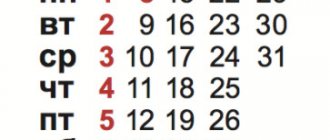Working time standards
Art. 91 of the Labor Code of the Russian Federation determines that the normal duration of work time is 40 hours/week , and it includes periods when a person is not engaged in direct work: breaks for rest and heating for builders and installers, loaders, drivers during a shift for 20 minutes at intervals of 2 hours.
The time for feeding the children of a working mother is also included in the amount paid according to the average earnings of the RV - Art. 258 TK. Calculation occurs in hours for a specific calendar interval: year, quarter, month .
Production calendar 2021 40; 39; 38.5; 36; 33; 30 hour work week
The specified 40 hours can be distributed over:
- A five-day week with two days off - in this case, employees will work 8 hours every day.
- A six-day work week with one day off - in this case, the duration of work during the day will be reduced. The maximum duration of work per day will be 7 hours.
Monthly standard The standard number of hours per month is established by determining the number of working days in a given period and the duration of one work shift.
The calculation takes into account holidays and weekends, as well as a mandatory reduction in working hours on pre-holiday days.
Shortened duration
According to Article 92 of the Labor Code, a reduced duration is introduced without taking into account the opinion of the employer in order to protect the health of the most vulnerable categories of workers . The standards are confirmed by Federal Laws (FL) of 2006 and 2013.
Reduced duration of time – the permissible number of hours/week applies to the following employees:
- Under 16 years old - 24, 16-18 years old - 35 hours per week.
- For disabled people of groups I and II, the duration of working hours is determined personally according to medical indications, but for workers in hazardous conditions - certified for degrees 3 and 4, in hazardous industries: the duration is no more than 36 hours / week. With the written consent of the employee, the standard is increased to 40 with the payment of a separately agreed compensation.
- For minor workers who combine production with training , the given standards are reduced by 50%. There are other categories of people and professions with reduced working hours.
Time to work
When hiring, the employee’s responsibilities, work schedule and salary, which directly depends on the time worked, are discussed. In addition to the employment contract, it is useful for a newcomer to study the internal company rules; these documents contain all the main provisions regarding labor regulations.
The working day must be of sufficient duration to ensure the required productivity and include time for rest before a new shift. The state also legally limits working hours.
Functions of working time: protective (have time to rest), production (have time to produce a product or provide a service), guarantee (work no longer than allowed by the state).
The usual length of time for work is no more than forty hours a week. The duration of work for a month, quarter or year is calculated based on this norm. The weekly rate cannot be increased, although a working week of 40–48 hours is sometimes considered acceptable.
The length of the working week was first established at the legislative level back in the 30s of the 20th century. It was then that the corresponding norms appeared in international documents.
For those who need protection from the state, a reduced duration of work has been established. For disabled people, working minors, and nursing mothers, it is important to consider how the working day is used. These categories of workers should have the opportunity to relax, maintain their health and develop personally.
Therefore, during the week, children 14-16 years old can work no more than 24 hours, teenagers 16-18 years old and people with disabilities (groups I, II) - no more than 35 hours, in hazardous work - no more than 36 hours a week.
Harmful production presupposes the presence of factors that, when exposed to the human body, lead to diseases. Among them: noise, vibration, electromagnetic radiation, chemical effects that cause carcinogenic and mutagenic changes in the body.
Another working time option is part-time. They agree on a part-time work schedule when applying for a job, but it is possible to switch to part-time work at any time. A part-time day is established indefinitely or for a certain period.
The standard working time is 40 hours per week, shortened working hours can be 24, 35 or 36 hours (for certain categories of workers).
Working day (shift)
A working day with a 40-hour week lasts 8 hours (Labor Code of the Russian Federation). To calculate the duration of work during the day, we divide the standard working time by 5 (five days). On the eve of the holiday, people work one hour less.
Read the full guide to introducing a shift schedule: https://ipshnik.com/rabota-s-kadrami/smennyiy-grafik-rabotyi-trudovoy-kodeks-norma-chasov.html
For those who work six days a week, the working day on Saturday should not be more than 5 hours.
A work shift can last up to 12 hours (workweek - 36 hours) or up to 8 hours (workweek - 30 hours or less), this is fixed in the agreement between management and employees and industry standards.
Table: working day and working week for different categories of workers
Operating time for a period (month, quarter, year)
We divide the weekly amount of work time (normal 40 hours or shortened - 24, 25, 36 hours) by 5 and multiply by the number of days of work per month (five-day week), from the quotient we subtract those hours by which working days were reduced before the holidays (if it is a holiday follows a day off, then on the day before the holiday they work as usual).
They work one hour less if the days December 31, February 22, March 7, April 30, May 8, June 11, and November 3 fall on weekdays.
Let's calculate the opening hours for February 2021.
We have: 28 calendar days, Sunday falls on the numbers: 4, 11, 18, 25.
In February there are 4 full weeks of 40 hours, one holiday and one pre-holiday day (minus one hour).
40 * 4 – 8 – 1 = 151 hours.
In total, we will work 151 hours in February.
The annual amount of working time is determined according to the same principle. We divide the weekly fund (40, 36, 35, 24 hours) by 5, multiply by the number of weekdays in a year for a five-day period. From the total we subtract the amount of hours by which working days were reduced before the holidays.
How to correctly fill out a time sheet: https://ipshnik.com/rabota-s-kadrami/vedenie-tabelya-uchyota-rabochego-vremeni.html
So, the working week is 40 hours (normal) or 36, 35 or 24 hours (shortened), the working day lasts 8, 7, 6 or 4 hours, respectively. Sometimes the working day is extended to 12 hours; this decision is fixed in the internal regulations.
Table: working time fund for the fourth quarter of 2021 (five days)
Let's calculate working hours and rest periods for normal and shortened durations for 2021.
Features of the work of teachers and doctors
Regulated by other governing documents. In relation to specialties in the field of education - Art. 333 of the Labor Code, and of medical institutions - 350 and Decree of the Government of the Russian Federation 101 of 2003. The standard working hours for teachers are 36 hours a week.
Physicians’ RV depends on the specialty and is determined by:
- according to the Lists of positions set out in three appendices to the resolution - 36, 33, 30 hours/week;
- according to the text of the document: work related to gamma irradiation in radiomanipulation laboratories and offices - 24 hours a week.
There are also regional restrictions regarding working women in rural areas in the Far North. For them, the norm of 36 hours/week is applied, unless there are grounds for establishing a shorter period .
Two questions remain unclear:
1. If, according to the legislator, the rights of rural women are infringed - they have to overwork, aren’t the rights of men in rural areas infringed? However, for them the payment procedure does not change. Apparently men can recycle for free.
2. Granting the right to a shortened working week to all women in the village, without distinction by profession, including employees of banks, administration, etc., the question arises: how does office work in the village differ from similar work in the city.
Thus, it is not entirely clear in whose interests the new law was adopted, and how to apply the rules in practice.
https://zakon-navigator.ru/zakon-o-sokrashhennom-rabochem-dne-dlja-zhenshhin-v-selskoj-mestnosti/
Part-time work
must be distinguished from shortened work time: in the first case, a shorter duration is determined for certain groups of specialists, in the second, by agreement of the parties, it is assigned to any worker, regardless of profession and production technology.
Another difference is in payment: with a shortened period, accruals are made as for full, and in the version of incomplete time - according to hours worked or from products produced.
According to Art. 93 of the Labor Code, the employer must establish a schedule for a part-time day, shift or week upon written request:
- an employee expecting a child;
- father, mother or guardian of a child of an employee - a caregiver with an unhealthy family member for a legally issued medical prescription.
In other cases, part-time work is introduced by agreement between the worker and the employer upon registration or subsequently. Art. 74 of the Labor Code provides for the initiative of the enterprise administration to establish part-time work - a day, a shift or a week.
Read more about part-time work here.
For some operating modes
There are legally defined standards for hours not only per week, but also per day. In such cases, questions of practical application do not arise. How to calculate the standard time for certain work modes:
- Part-time work – the maximum duration of a shift is limited by art. 284 TK and is 4 hours. The exception is days when the employee is not busy working at the main enterprise, then he can work full time in an additional place. But the total time spent on a part-time job cannot exceed 50% of the accounting period quota.
- Irregular working hours - this regime presupposes the employer’s right to involve the worker in performing tasks beyond the established duration of the shift: Art. 101 Labor Code of the Russian Federation. But such a practice can only be episodic and should not acquire features of regularity. This regime should not be confused with overtime work, when guarantees are provided regarding the limitation of overtime hours. It is possible to combine irregular days with part-time work.
- A six-day week - its duration is the same as that of a five-day period: 40 hours, but the length of the working day is not established by law. Only the shift before the weekend is limited: 5 days*7 hours+1*5=40. With an abbreviated RT, it looks like 6*6=36.
By establishing normal working hours, the legislator established the limit of permitted labor.
Taking into account the Labor Code, by agreement between the employer and the citizen, a different duration of work placement may be determined, but not more than 40 hours/week .
Who has the right to apply for a shortened working week?
The concepts of reduced working hours and part-time work should not be confused, due to the fact that they are not identical. Their fundamental differences are reflected in Russian labor legislation, namely in Art. 92, 93 Labor Code of the Russian Federation.
Part-time work is a time interval of less than 40 hours weekly during which an employee performs his professional duties.
In practice, part-time work can be implemented in the form of a part-time working day or part-time work shift, if we are talking about a shift work schedule. There is also a part-time working week. The employer and employee have the right, under contractual conditions, to use a mixed type, when one employee is subject to part-time work with an incomplete work week (for example, an employee works in the organization weekly for 3 days for 5 hours).
Certain groups of employees, due to their status, have the right to apply for part-time work. These include:
- Pregnant women;
- Parents (only one), guardians or trustees who have children under 14 years of age, disabled minors;
- Employees who care for sick family members. This right is available only if there are documented medical reports);
- Female workers who have children under 3 years of age. These may also include fathers, grandparents, as well as other relatives who actually care for the child;
- Worker-students who study in the correspondence department of graduate school.
How can these categories work part-time? To do this, it is enough to contact the head of the employing company with a written application. This document must specify the desired duration of working hours and the date from which it will be applied, as well as the grounds on which the employee has the opportunity to obtain this work schedule. The employer must also be provided with a document actually confirming the existence of the basis.
The Labor Code of the Russian Federation establishes the possibility of a 36-hour working week for the following categories of working citizens:
- Personnel who are employed in enterprises characterized by negative working conditions for life and health;
- Female employees who carry out their professional activities in the Far North and similar territories;
- Female employees who live and carry out their professional activities in rural areas.
However, the use of part-time work for staff is not always carried out at the will of the company’s employees - in some cases the employer acts as the initiator. For the most part, this situation occurs due to a negative trend in the development of a commercial organization. The introduction of this regime must be logically justified and can be established for a period of no more than six months in connection with the requirement prescribed in Article 74 of the Labor Code of the Russian Federation.
A five-day work week with two days off is most often implemented in real life as a 40-hour work week. However, the presence of a certain status of employees and specific working conditions makes it possible to approve a shortened working week of 36 hours for personnel.
Similar articles
- Sample working time schedule
- Sample work schedule
- Average working day formula
- Work and rest schedule at the enterprise
- What is the maximum duration of overtime work?
Permission from Rostrud
State labor inspectors indicated that for the majority of employees, the duration of working hours as required by the Labor Code is considered to be 40 hours or less . At the same time, the maximum length of the day is established only for a few categories of specialists.
In addition to restrictions on the duration of shifts for minors, there are rules for other beneficiaries:
- for disabled people - according to medical reports;
- for workers in harmful and dangerous industries: in a 36-hour week - 8, 30-hour - 6 hours;
- For drivers of electric and motor vehicles, standards are regulated for specific types of transportation equipment.
Rostrud explains that the maximum shift for all other categories of workers is not approved by law. Enterprises and organizations, including individual entrepreneurs, have the right to independently determine the length of the working day within the framework of internal regulations .
When, according to production conditions, it is necessary to reduce the time limit on Wednesday or Thursday, this is permitted. The excess freed up time can be added to other shifts.
The work schedule of the organization's employees is included in the contract and approved by the orders of the manager .








